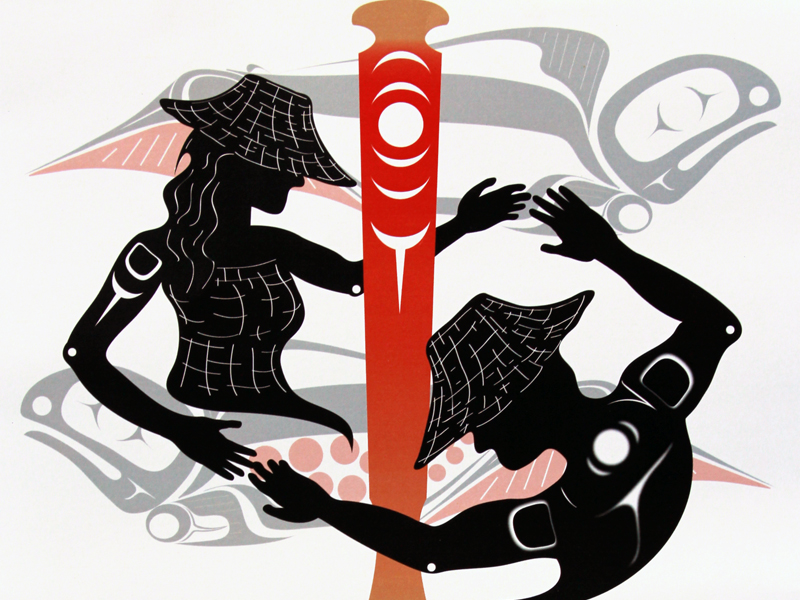Turning the wheels of change: Indigenizing the Academy
- Robie Liscomb

In the recent past, colonizers used education-most notably in the form of residential schools-as a powerful weapon in an effort to destroy Indigenous cultures. In late August, more than 250 people from 33 postsecondary educational institutions across Canada gathered at the Chilliwack campus of the University of the Fraser Valley-in traditional St&o#180;:lÅ territory-to explore ways to make postsecondary education serve Indigenous students and their communities better.
Over two days, administrators, faculty members, students, community members and Elders discussed ways to better integrate First Nations values and culture into postsecondary institutions. Participating from UVic were AVP Academic Planning Dr. Catherine (Katy) Mateer (VPAC), Acting Director of the Office of Indigenous Affairs Ruth Young, Aboriginal Service Plan Manager Gina Starblanket, Dr. Robina Thomas (social work), LE,NONET Academic Lead Dr. Rob Hancock (anthropology), and Trevor Good, graduate student in the Master's of Social Work Indigenous stream.
"Indigenizing the academy" was the explicit theme, and topics discussed included recruitment and retention of Indigenous students and faculty, curriculum transformation, support services and facilities, governance issues and relations with Indigenous communities.
"What 'Indigenizing the academy' means to me is how we engage with one another, learn from each other, and work together to address the needs of Indigenous students and communities," says Mateer, who points out that it concerns everyone, not just Indigenous peoples. "It's important, for example, that every postsecondary student have an understanding of Indigenous cultures."
The gathering was the first of its kind and a venue for sharing best practices.
"The conference was a good opportunity to see what's going on at other postsecondary institutions," Mateer says. "I feel that we at UVic have come a long way, but there's still so much more that we could do."
"People came up to me after the sessions to ask about what UVic is doing," says Hancock. "UVic is seen as a leader in a number of areas. But it's important that we keep our focus not just on what we're doing well, but on what's left to do. There's no point in recruiting more and more Indigenous students if we're not going to change the institutional culture." In that regard, Hancock suggests that the task would be better conceptualized as decolonizing the campus rather than Indigenizing it.
Indigenous students still face stigma and prejudice that institutions must address. "In the sessions with students that I participated in," says Good, "the discussion kept coming back to horror stories they had personally experienced. A friend of mine says 'Big wheels turn slowly,' but not so long ago our people were underneath those wheels. There's a lot of work to be done in creating safe spaces and safe pathways through postsecondary education," Good says.
The participants from UVic came back with several ideas of things that others have done that the university could consider here. Starblanket pointed out that some institutions have a mandatory Indigenous Studies course. Trent's Department of Indigenous Studies is now over 40 years old and it includes a PhD program, whereas UVic has only an Indigenous Studies minor. Although UVic is a leader in terms of undergraduate scholarships and bursaries for Indigenous students, more financial aid is needed at the graduate level. Other institutions have a more extensive network of Indigenous advisers across the academic landscape. And several UVic participants voiced concern about the long-term sustainability of Indigenous cultural and support components that are dependent on outside funds or special-project dollars rather than ongoing core funding.
"I left the conference with more questions than answers," says Thomas. "Where is UVic in terms of our institutional culture? Where do we think we are and where could we be? We need to dare to dream and have a vision."
One thing to our advantage, Thomas points out, is the level of goodwill and investment in the issues here at UVic. "We are able to sit together and have this frank conversation," she says. "We've developed a level of respect for each other and our differences."
__________________
UVic's strategic plan (Objective 3) includes, among other things, an institutional commitment to "programs of recruitment, retention, education and services for Indigenous students in all faculties."
A new section of the UVic website has recently been launched that serves as a portal to academic programs and courses with an Indigenous focus, research related to Indigenous cultures and issues, services for Indigenous members of the university, and partnerships between Indigenous communities and the university. www.uvic.ca/partners/indigenous/

